|
|
T. J. Plummer, Aerated Water Manufacturer
Site navigation - please use menu on left (click here to display it if not visible). If problems, use site map.
|
T. J. Plummer, Aerated Water Manufacturer Site navigation - please use menu on left (click here to display it if not visible). If problems, use site map. |
|
by Tom Plummer |
|
|
|
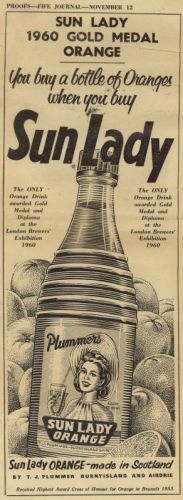 TJ
Plummer Aerated Water Manufacturer was established in 1939 just prior
to the start of the Second World War by Thomas James Plummer who had
previously worked as a driver salesman for William Smith, Milton
Bridge, another Aerated Water Manufacturer.
TJ
Plummer Aerated Water Manufacturer was established in 1939 just prior
to the start of the Second World War by Thomas James Plummer who had
previously worked as a driver salesman for William Smith, Milton
Bridge, another Aerated Water Manufacturer.
It was his ambition to start his own business and to this end he bought James Bisset, Aerated Water Manufacturer, 43 Somerville Street, Burntisland.
On the advent of the war the Soft Drinks industry was subjected to rationing for ingredients, petrol and almost all the other necessities for production and distribution and sold at prices fixed by the authorities. During this period TJ Plummer solely, was allowed to supply businesses in Burntisland, Kinghorn and Aberdour but no further. I am sure Captain the horse was glad of this, as he was used regularly to deliver the products, during this period of petrol rationing.
After the war Plummer’s soon became a major local supplier in the Fife area and, a significant local employer reaching 30 at one point. Eventually their bottled products were sold throughout central Scotland under the Plummer name and also “Koolopop” which soon became a favourite, especially with school children. Koolopop was marketed by a separate company that was formed, called Sokool.
This was a very innovative company and in the 1950’s introduced cartons of ready to drink orange squash for sale in the Cinemas even supplying refrigerators to store the drinks, as they were made from the fruit and benefited from being stored at a low temperature. The company supplied most of the major cinema chains in Scotland using their own vehicles based in Burntisland. This part of the business was eventually sold to Kia Ora Cup Squash, a division of Schweppes Ltd, with Plummer’s undertaking to manufacture and supply their products in Scotland. This entailed opening a factory in Airdrie which was also used as a depot to supply retail outlets with bottled soft drinks in the Lanarkshire and Glasgow areas.
During the 1960’s vending machines took an upsurge which created a new market for concentrated syrups and Plummer’s became a major supplier to the vending industry throughout the UK and even exported to Finland: they gained a reputation for quality products at reasonable costs.
With their knowledge of
concentrated products Plummer’s extended their range to supplying home
machine concentrates suitable for all home drinks dispensers, along
with the re-chargeable CO2 Gas cylinders, throughout Scotland.
November 1978 saw the introduction of Plummer’s soft drinks in 1 Litre returnable bottles packed in special display cases with a sliding bar that allowed them to be used as a display rack as well.
Such was the quality of Plummer’s products that many awards were won over the years including the Croix d’ Honneur from an international competition held in Brussels in 1953, plus gold and silver awards from various UK competitions.
In 1980 due to lack of space to install new production machinery and increase the storage area, it was decided to look for new premises. As no suitable site or buildings were available in Burntisland it was eventually decided to move to a pre built factory in Cowdenbeath which was of the required size and, available to move into immediately. This was a very necessary decision at this point and was not taken lightly considering our long association with Burntisland and the loyal and supportive local people who made up our work force over the past 41 years.
Over the next decade the Soft Drinks Industry went through a decline of local manufacturers due mainly to the ever increasing growth of the supermarkets. This led to the closure of many corner shops which was their core business. The advent of the non returnable plastic bottle and canned soft drinks also meant the supermarkets were now able to sell carbonated soft drinks to an extent not previously possible with the returnable glass bottle: they had not been willing to handle them due to the complication of refunding the deposits.
Supermarkets preferred one supplier and were now also selling their own brand of soft drinks. A local manufacturer could not compete in the market unless it was of sufficient size to produce the desired volume and meet the price requirements.
The Cash & Carry business also preferred handling the plastic bottle which made them available to all individual outlets that sold soft drinks.
The financial backing and marketing expertise of the major manufacturers as well as the fact that they had national coverage and distribution allowed them to develop the market. The result was the dominance of the brand leaders which were demanded by the public and were regarded as a “must stock” item by retail outlets.
Plummer’s Soft Drinks eventually felt the impact of the above as all our standard shop outlets were affected by the plastic bottle and the vending industry by demand for national branded canned soft drinks.
The result was the business was sold to Woodrow’s Soft Drinks of Dunfermline in late 1990.
It is of note that the originator of Plummer’s had been still involved in the business and was a director along with his two sons at this point.
It is of interest that a Mineral Water Trade book lists 170 Aerated Water Manufacturers in Scotland in 1939 and at the date of writing this précis (June 2010) the number can be counted on one hand.
~~~~~~~~~~
Postscript: Surviving Bottles
In May 2018, Douglas Kellett got in touch with Burntisland Heritage Trust to let us know that he had found a Plummer's bottle, unbroken and complete with its cap. He found it on a wildlife trek on his local patch, lying in the middle of a reedbed (with a lochan nearby) near Selkirk in the Scottish Borders. He speculated that it might have been dislodged from its original resting place by the winter floods two years before, or that perhaps it had always been there. Douglas also sent us five photos of the bottle - see below.
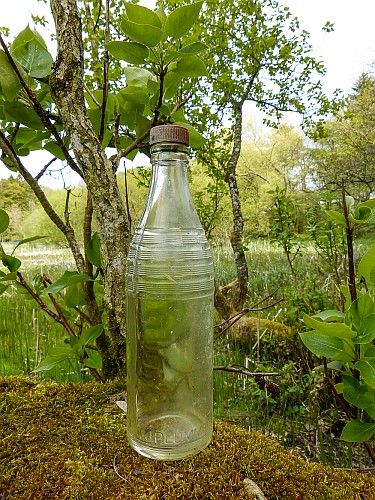
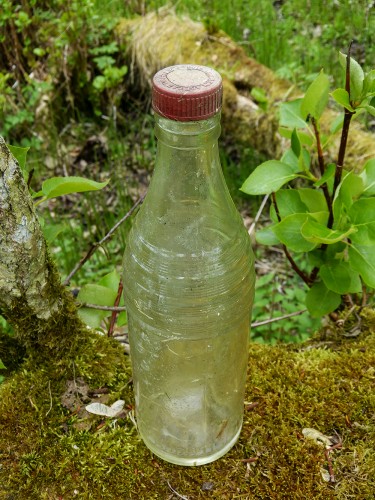
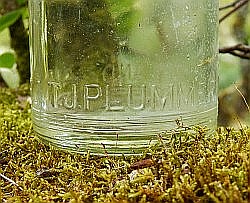
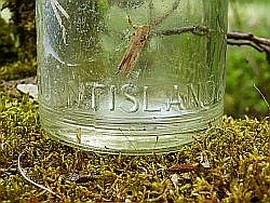
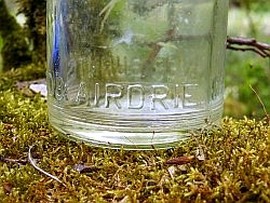
In May 2020 Stef Scott sent us the two photos below. They show a T.J. Plummer bottle stopper that she had recently found on the banks of the River Kelvin in Glasgow. It was still inside the neck but the rest of the bottle was long gone sadly.
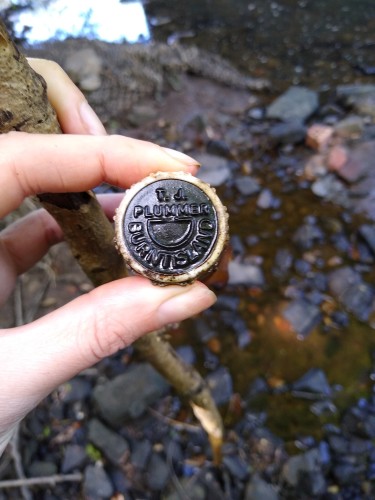
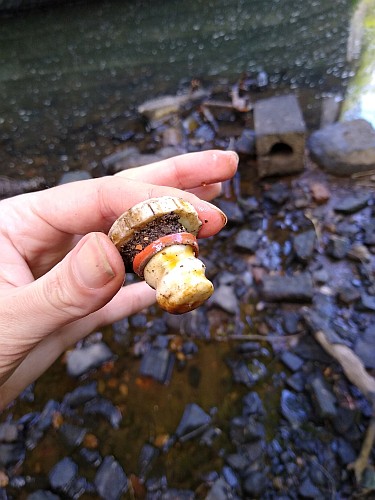
On 4 June 2021, Brian Biggar discovered a complete T.J. Plummer bottle in Burntisland. Brian commented: "I thought you might like these photos of a T.J. Plummer bottle that I dug out of the terraces at Rossend Castle last night. It must be from at least the 60s or earlier as it has a twist top with a rubber bung." Back and front views of the bottle are shown below.
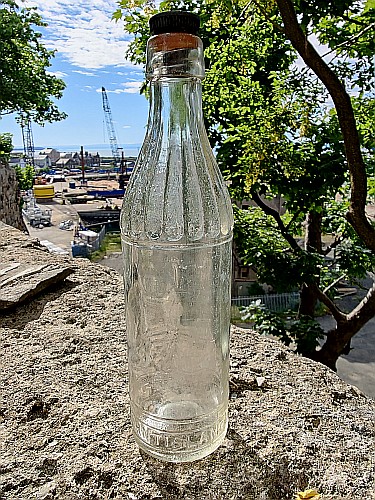
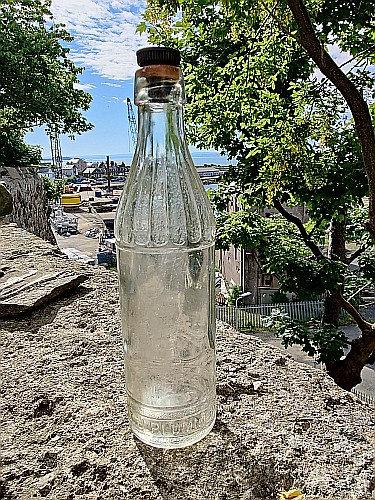
Webpage by Iain Sommerville;
Help on bookmarking this page.